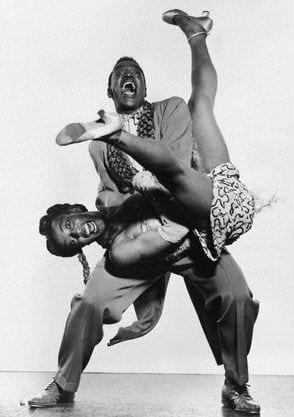Swing Dance: Jazz Roots and African American Art
Jazz dance began in the eighteenth century as a way for African slaves in America to keep their culture close. Traditionally, the dance was celebratory, and earth focused. Dancers kept themselves grounded and felt the pulsing vibrations of African drums through the earth. This happy and naturally human dance became their glue throughout slavery. In New Orleans, African slaves gathered to dance and socialize, but their dancing and drums were not understood by Americans. When Americans restricted their dancing, they began to meet in secrecy, giving rise to street dances influenced by jazz music and ragtime.
Of course, these street dances found their way into all the underground jazz clubs during prohibition. The styles formed from African dances made their way into the umbrella term “swing”. The popular styles “lindy hop”, “balboa”, and “shag” all evolved from African dances and jazz. When watching these completely different dances, we don’t see their similar origin. Balboa, a small stepped close form dance evolved because of strict Southern California rules where kicks and big movements were prohibited. The dance itself almost made a mockery of the rules it followed. The incredibly upright posture and tiny steps still look lively. People today who don’t know about balboa origins think the dance is humorous when they first begin. It is awkward to learn, but that is the entire point. The laws that had to be followed are actually ridiculous. When the same people who feel awkward beginning Balboa see a professional, they are usually quite impressed. This is a perfect example of how African Americans made an incredibly complex art, despite people who made every effort to keep them from doing so. My personal favorite form of jazz dance is West Coast Swing. It is danced to more smooth blues and funk music, which is actually the furthest from the traditional African origins. Even so, it is still incredibly grounded compared to dances that do not fall under the swing category. It relies on a strong partner connection and understanding that African artforms tend to focus in on.
Lindy Hop is balboa on a grander scale. Kicks and flips can be expected in this wild eight count dance. This style is probably closest to its original origins. It is also closely related to Lindy Charleston, which starts with a grounded pulsing and swiveling feet and can take many forms either with a partner or solo. These forms of jazz dance, when done with a partner, rely almost entirely on connection and decisive action.
There is a long list of swing dances that came from jazz, however, they all have one thing in common. They are incredibly free spirited and flexible. In other words, they are fun. Swing dancing is popular today in the styles from the 1920’s to the 1950’s. There are dance studios that mimic the feel of the 1920’s, people have Gatsby dance parties, and so on and so forth. In my opinion, this is a problem. There is not enough recognition for the history of jazz and jazz dances. These dance clubs are mostly white and exclude the history, culture, and people from a fascinating form of art. Jazz dance is under looked as an artform and deserves to have its roots honored and its beauty admired, not diminished by people who don’t understand what lies behind it.


